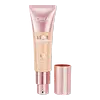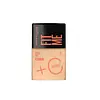What's inside
What's inside
 Key Ingredients
Key Ingredients

 Benefits
Benefits

 Concerns
Concerns

 Ingredients Side-by-side
Ingredients Side-by-side

Water
Skin ConditioningIsododecane
EmollientCoco-Caprylate/Caprate
EmollientDicaprylyl Carbonate
EmollientGlycerin
HumectantPEG-30 Dipolyhydroxystearate
EmulsifyingZea Mays Starch
AbsorbentButylene Glycol
HumectantNiacinamide
SmoothingAscorbyl Glucoside
AntioxidantPentylene Glycol
Skin ConditioningPhenoxyethanol
PreservativeMagnesium Sulfate
Caprylyl Glycol
EmollientSorbitol
HumectantDisteardimonium Hectorite
StabilisingSynthetic Fluorphlogopite
Tocopherol
AntioxidantSilica Silylate
EmollientSodium Stearate
CleansingCetearyl Alcohol
EmollientPropylene Carbonate
SolventSodium Hydroxide
BufferingDisodium Stearoyl Glutamate
CleansingCeteareth-20
CleansingCalcium Chloride
AstringentAluminum Hydroxide
EmollientMica
Cosmetic ColorantCI 77491
Cosmetic ColorantCI 77492
Cosmetic ColorantCI 77499
Cosmetic ColorantCI 77891
Cosmetic ColorantWater, Isododecane, Coco-Caprylate/Caprate, Dicaprylyl Carbonate, Glycerin, PEG-30 Dipolyhydroxystearate, Zea Mays Starch, Butylene Glycol, Niacinamide, Ascorbyl Glucoside, Pentylene Glycol, Phenoxyethanol, Magnesium Sulfate, Caprylyl Glycol, Sorbitol, Disteardimonium Hectorite, Synthetic Fluorphlogopite, Tocopherol, Silica Silylate, Sodium Stearate, Cetearyl Alcohol, Propylene Carbonate, Sodium Hydroxide, Disodium Stearoyl Glutamate, Ceteareth-20, Calcium Chloride, Aluminum Hydroxide, Mica, CI 77491, CI 77492, CI 77499, CI 77891
Water
Skin ConditioningHomosalate
Skin ConditioningDicaprylyl Ether
EmollientGlycerin
HumectantSilica
AbrasiveAlcohol Denat.
AntimicrobialEthylhexyl Salicylate
UV AbsorberOctocrylene
UV AbsorberPolyglyceryl-4 Isostearate
EmulsifyingDisteardimonium Hectorite
StabilisingTribehenin
EmollientPEG-30 Dipolyhydroxystearate
EmulsifyingSynthetic Fluorphlogopite
Sodium Chloride
MaskingPhenoxyethanol
PreservativeSilica Silylate
EmollientAscorbyl Glucoside
AntioxidantDisodium Stearoyl Glutamate
CleansingEthylhexylglycerin
Skin ConditioningAdenosine
Skin ConditioningAluminum Hydroxide
EmollientTocopherol
AntioxidantCI 77891
Cosmetic ColorantCI 77491
Cosmetic ColorantCI 77492
Cosmetic ColorantCI 77499
Cosmetic ColorantWater, Homosalate, Dicaprylyl Ether, Glycerin, Silica, Alcohol Denat., Ethylhexyl Salicylate, Octocrylene, Polyglyceryl-4 Isostearate, Disteardimonium Hectorite, Tribehenin, PEG-30 Dipolyhydroxystearate, Synthetic Fluorphlogopite, Sodium Chloride, Phenoxyethanol, Silica Silylate, Ascorbyl Glucoside, Disodium Stearoyl Glutamate, Ethylhexylglycerin, Adenosine, Aluminum Hydroxide, Tocopherol, CI 77891, CI 77491, CI 77492, CI 77499
 Reviews
Reviews

Ingredients Explained
These ingredients are found in both products.
Ingredients higher up in an ingredient list are typically present in a larger amount.
Aluminum Hydroxide is a form of aluminum. It can be naturally found in nature as the mineral gibbsite. In cosmetics, Aluminum Hydroxide is used as a colorant, pH adjuster, and absorbent.
As a colorant, Aluminum Hydroxide may add opacity, or reduce the transparency. Aluminum hydroxide is contains both basic and acidic properties.
According to manufacturers, this ingredient is an emollient and humectant. This means it helps hydrate the skin.
In medicine, this ingredient is used to help relieve heartburn and help heal ulcers.
There is currently no credible scientific evidence linking aluminum hydroxide in cosmetics to increased cancer risk.
Major health organizations allow the use of aluminum hydroxide in personal care products and have not flagged it as a carcinogenic risk at typical usage levels.
Learn more about Aluminum HydroxideAscorbyl Glucoside is a stable form of Vitamin C. It is created by combining glucose from starch.
When applied to skin, Ascorbyl Glucoside turns into Ascorbic Acid.
Ascorbyl Glucoside is an antioxidant. Antioxidants help fight free-radicals, or molecules that may damage skin cells.
It can help to reduce redness, improve skin texture, reduce the effects of aging, reduce the visibility of dark spots, and brighten skin.
Read more about other types of Vitamin C:
Learn more about Ascorbyl GlucosideCi 77491 is also hydrated iron III oxide. It's sole purpose is to give a red/pink hue to products.
Iron III oxides are classified as inorganic chemicals for coloring.
Synthetically created Ci 77491 is considered safer than those naturally found. This is because the synthetically created version may contain less impurities. Iron oxides are generally non-toxic and non-allergenic.
Learn more about CI 77491Ci 77492 is also hydrated iron III oxide. It's sole purpose is to give a yellow hue to products.
Iron III oxides are classified as inorganic chemicals for coloring.
Synthetically created Ci 77492 is considered safer than those naturally found. This is because the synthetically created version may contain less impurities. Iron oxides are generally non-toxic and non-allergenic.
Learn more about CI 77492Ci 77499 is also hydrated iron III oxide. It is created from mixing red and black iron oxides. This helps give shades of darkness to a product.
Iron III oxides are classified as inorganic chemicals for coloring.
Ci 77891 is a white pigment from Titanium dioxide. It is naturally found in minerals such as rutile and ilmenite.
It's main function is to add a white color to cosmetics. It can also be mixed with other colors to create different shades.
Ci 77891 is commonly found in sunscreens due to its ability to block UV rays.
Learn more about CI 77891DSG is used as a surfactant.
Surfactants are cleansing ingredients that help remove oil, dirt, and other impurities from the skin. They work by reducing surface tension between water and oils/dirt to allow them to be easily rinsed away.
Disteardimonium Hectorite comes from the clay mineral named hectorite. It is used to add thickness to a product.
It can also help stabilize a product by helping to disperse other ingredients.
Hectorite is a rare, white clay mineral.
Learn more about Disteardimonium HectoriteGlycerin is already naturally found in your skin. It helps moisturize and protect your skin.
A study from 2016 found glycerin to be more effective as a humectant than AHAs and hyaluronic acid.
As a humectant, it helps the skin stay hydrated by pulling moisture to your skin. The low molecular weight of glycerin allows it to pull moisture into the deeper layers of your skin.
Hydrated skin improves your skin barrier; Your skin barrier helps protect against irritants and bacteria.
Glycerin has also been found to have antimicrobial and antiviral properties. Due to these properties, glycerin is often used in wound and burn treatments.
In cosmetics, glycerin is usually derived from plants such as soybean or palm. However, it can also be sourced from animals, such as tallow or animal fat.
This ingredient is organic, colorless, odorless, and non-toxic.
Glycerin is the name for this ingredient in American English. British English uses Glycerol/Glycerine.
Learn more about GlycerinPEG-30 Dipolyhydroxystearate isn't fungal acne safe.
Phenoxyethanol is a preservative that has germicide, antimicrobial, and aromatic properties. Studies show that phenoxyethanol can prevent microbial growth. By itself, it has a scent that is similar to that of a rose.
It's often used in formulations along with Caprylyl Glycol to preserve the shelf life of products.
Silica Silylate is a siloxane polymer, meaning it is made up of silicon and oxygen atoms. It is not soluble in water.
This ingredient is a white powder with oil-absorbing, emollient, and anticaking properties.
Synthetic Fluorphlogopite is the synthethic version of mica. It consists of fluorine, aluminum and silicate.
Synthetic Fluorphlogopite is used to add volume to products.
It is considered non-irritating on the skin.
Learn more about Synthetic FluorphlogopiteTocopherol (also known as Vitamin E) is a common antioxidant used to help protect the skin from free-radicals and strengthen the skin barrier. It's also fat soluble - this means our skin is great at absorbing it.
Vitamin E also helps keep your natural skin lipids healthy. Your lipid skin barrier naturally consists of lipids, ceramides, and fatty acids. Vitamin E offers extra protection for your skin’s lipid barrier, keeping your skin healthy and nourished.
Another benefit is a bit of UV protection. Vitamin E helps reduce the damage caused by UVB rays. (It should not replace your sunscreen). Combining it with Vitamin C can decrease sunburned cells and hyperpigmentation after UV exposure.
You might have noticed Vitamin E + C often paired together. This is because it is great at stabilizing Vitamin C. Using the two together helps increase the effectiveness of both ingredients.
There are often claims that Vitamin E can reduce/prevent scarring, but these claims haven't been confirmed by scientific research.
Learn more about TocopherolWater. It's the most common cosmetic ingredient of all. You'll usually see it at the top of ingredient lists, meaning that it makes up the largest part of the product.
So why is it so popular? Water most often acts as a solvent - this means that it helps dissolve other ingredients into the formulation.
You'll also recognize water as that liquid we all need to stay alive. If you see this, drink a glass of water. Stay hydrated!
Learn more about Water